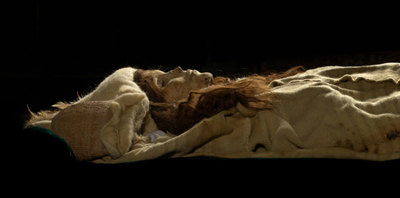Secrets of the Silk Road

With graceful eyelashes, long flaxen hair and serene expression, the "Beauty of Xiaohe" seems to have just softly fallen to sleep — yet she last closed her eyes nearly 4,000 years ago. She was found in 2003, one of hundreds of spectacularly preserved mummies buried in the desert sands of the vast Tarim Basin, in the Far Western Xinjiang Uyghur Autonomous Region of China. This "Beauty of Xiaohe" and more than 100 objects, 700 to 3,800 years old, have traveled for the first time to the East Coast, where Secrets of the Silk Road is being exhibited at the University of Pennsylvania Museum of Archaeology and Anthropology in Philadelphia through June 5, 2011, before returning to China.
Penn Museum's exhibition will provide a new context for the Secrets of the Silk Road material, drawing upon the rich history of Central Asia's Tarim Basin desert, and the mystery of the peoples who lived there or passed through so long ago. Opportunities to 'Unravel the Secrets' draw visitors into some of the issues, and discoveries, that engage scholars today. New interactive components in the exhibition are designed to engaged visitors of all ages with the ancient artifacts and principal themes; what can the variety of textiles made and traded in the region, an astonishing range of languages, and exceptionally preserved mummification, reveal about this region of the Silk Road? A full schedule of complementary Silk Road programming, designed for diverse ages and interests, continues throughout the exhibition.
The new presentation was developed by the Penn Museum's exhibition team in close collaboration with Victor Mair, Penn Museum consulting scholar and professor of Chinese Language and Literature at the University of Pennsylvania. Credited with "rediscovering" the Tarim Basin mummies for the West on a trip to the region in the 1980s, Dr. Mair has engaged in intensive research on Xinjiang archaeology since then.
"This traveling exhibition of materials from half way around the world is opening new doors— providing visitors with an unparalleled opportunity to come face to face, literally, with life in East Central Asia, both before and after the formation of the fabled Silk Routes that began more than 2,000 years ago," said Dr. Mair.
Pages: 1 · 2
More Articles
- National Archives Records Lay Foundation for Killers of the Flower Moon: The Osage Murders and the Birth of the FBI
- Nichola D. Gutgold - The Most Private Roosevelt Makes a Significant Public Contribution: Ethel Carow Roosevelt Derby
- Oppenheimer: July 28 UC Berkeley Panel Discussion Focuses On The Man Behind The Movie
- The Beige Book Summary of Commentary on Current Economic Conditions By Federal Reserve District Wednesday November 30, 2022
- A la Frank Sinatra: "Come Fly With Me", U.S. Department of Transportation Airline Customer Service Dashboard
- "Henry Ford Innovation Nation", a Favorite Television Show
- Board of Governors: Minutes of the Federal Open Market Committee June 14–15, 2022; Consumer Price Inflation Remained Elevated
- Julia Sneden Wrote: Going Forth On the Fourth After Strict Blackout Conditions and Requisitioned Gunpowder Had Been the Law
- Joan L.Cannon Wrote: A Family Inheritance: More Than 'Things' ... Emblems of Our Lives
- Jo Freeman Reviews: Gendered Citizenship: The Original Conflict Over the Equal Rights Amendment, 1920 – 1963






